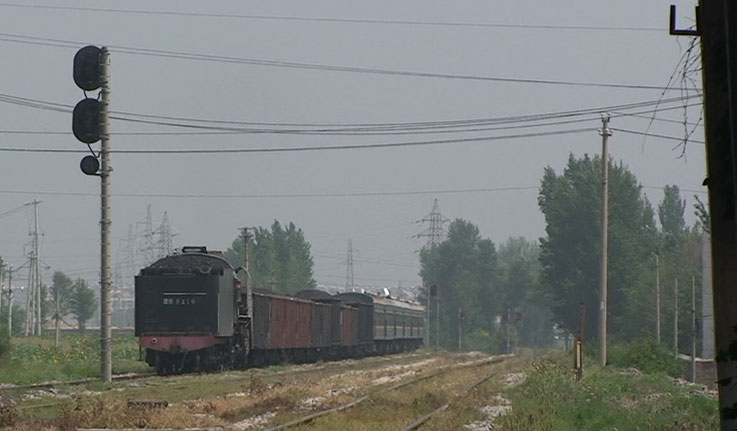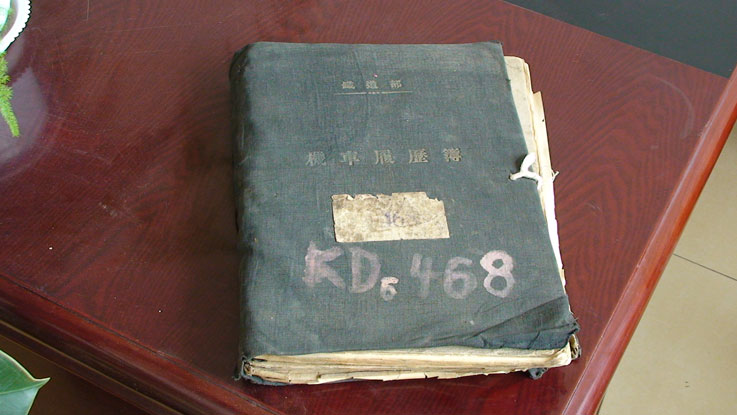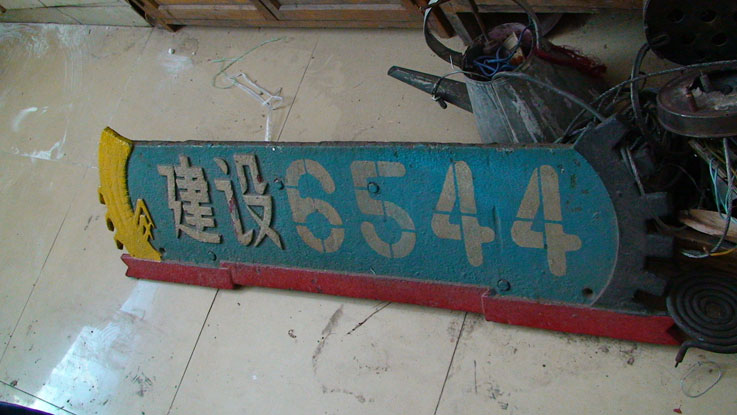

The last steam-hauled standard-gauge
mixed train in the world?
The last JS hauled passenger train?
One of the last locations to see JS at work.
29 July
Given the above comments, surely Yuanbaoshan should be on the list of must-see places in China. However, the short (10km) mainline which has the passenger service is only at all scenic in the middle section after the big bridge. The bridge itself is not photogenic although this may improve once the new road bridge has been completed. The middle section has a couple of curves through sandy area with young trees well clear of the tracks and although the loco doesn't have to work hard here it chuffs quite nicely. It could also be quite pleasant curving around toward the level crossing before the mine terminus but it is defintely downhill there.
The train itself is a bit problematic. Next to the engine are around 15 coal wagons followed by a 6 coach passenger rake. Seen below with is the tender-first return version, the problems of taking a decent photo of the whole train will be clear. With the train running through a video sequence, this is not such a big problem.

Chimney-first mixed trains leave Yuanbaoshan at 0700 and 1400 and return around 1100 and 1800. The destination is the mine at Fengshuigou. With no hotel in Yuanbaoshan, the challenge is to get there for the morning working in summer from the nearest hotels in Chifeng or Pingzhuang. The power station is the main user of coal and a diesel takes the wagons round to the plant from Yuanbaoshan.
There were 2 locos in steam JS8418 on the mixed and JS8250. This loco was also seen to do some shunting and may make occasional trips to the other mines or to China rail. There was a third loco in the shed at Yuanbaoshan - JS8242.

Everyone is very friendly here and the engineer showed us his collected on photos, log books and plates.

This is KD39 which formerly worked at Yuanbaoshan. The engineer said it was British but I will need to check.
(Update 6 August) Roger Gillard writes:
I've got in touch with two of my China guru's in relation to the fascinating
photo you uncovered in Yuanbaoshan. Both Bob Koch and Bill Pearce are sure it
is a KD3 built in China. The number does not fit with the class but that can
be explained but renumbering in industrial service. ...
(Bob Koch wrote:) Thanks for the very
rare and interesting photo, which I haven't seen before. I believe it's a shot
of an ex-South Manchuria Railway SoriShi (SR-4) 2-8-0 class, one of a group
of 13 (1200-1212) built at the SMR's Shakako Shops in Dairen (Dalian) in 1914.
This group is significant because it's the first batch of locos actually built
from scratch, raw material at Shakako, rather
than 'erecting' dis-assembled locos shipped in from abroad. The story of its
British origins is partly right. The SMR had several
classes of Sori (conSoRidation) preceding these home-built Shakako machines.
Besides a slew of Alco and Baldwins, the SoriSa (SR-3) class 1068-1107 was built
by Beyer Peacock in 1910-11. Although the SMR was a "typical America railway",
locos, rolling stock, etc, they chose to copy a British design as their first
home-built attempt. Externally, except for the Belpaire firebox - rare in China,
they don't look all that similar, but the boiler data and running gear dimensions
are nearly identical. While studying the picture, (with the running gear obscured
by most of the roundhouse staff), I noticed the following things that led to
my conclusion.
1. Belpaire firebox. rare in China
2. Drifting valves. even rarer in China
3. Two round 'plates' on the smokebox side.
4. A length of 'pipe' on the smokebox side under one plate
5. What looks like the Shakako builders plate on the smokebox side
These last three items all arranged uniquely together. I compared this to a
builders photo of SoriShi No.1200 which appeared in
the British Railway Magazine March 1915, page 219. The PRC number KD-39 was
of some help, but only after I checked under KD-3, which is the group of Beyer
Peacock and Shakako locos of similar design. The Shakako examples should be
146-155, so No.39 (or 9) doesn't fit anywhere. It may be a later adjustment
in number.
This is what I got from Bill Pearce
( a mate of mine in Melbourne, also with lots of knowledge in the field):
Roger,
Mysterious loco identified. ... This is SMR SoRi Shi (4) class, first built
in Taisho Year 3 (1914) at SMR Shaheko Works, Dairen. Altogether, thirteen were
built, the last in 1920. They went to Manchukuo National Rly in 1933. See Carter,
p. 256. He gives them as People's Railway class KD3. However, number 39 is not
correct for KD3, according to Chinese Tech. Data book, these were 146-155. Peter
Clark has KD3's as ex Penn. R.R. locos, sold to Manchukuo National in 1939,
probably added to the existing SoRi Shi's, they appear similar in size to the
Shaheko locos. An interesting find, first evidence of this class in People's
Rly. service, but the number 39 is strange. Perhaps by the time that the photo
was taken, all KD 1's in that low number series had gone, and this loco took
one of the vacated numbers.)
I note from the above that SoRi stands for conSoRidation just as KD also stands for KonsoliDation. Consolidation is (I believe) the name the Americans gave to the 2-8-0 wheel arrangment. The Japanese must have revised their nomenclature at some point. I assume this was due to a (political?) decision to change from use of Japanese Katakana (SoRi = ソ リ and fits with Katakana) to Romaji (English Alphabet). KD fits with the use of the English alphabet not Katakana. (John Raby)

This is the log book for KD6 468 now at Tiefa.

This front number off JS6544 would be a bit too heavy to take away as a souvenir.
John Raby
Pingzhuang